Key takeaways:
- Selective mutism is an anxiety disorder characterized by the inability to speak in specific social situations, deeply influenced by individual personality traits and environmental factors.
- Creating a safe and supportive environment, along with gradual exposure, can significantly help individuals with selective mutism overcome communication barriers.
- Personal strategies, such as using non-verbal communication, setting small goals, or having a support buddy, can empower individuals to engage in group settings.
- Vulnerability in sharing personal experiences can strengthen connections and foster inclusivity among peers facing similar challenges.
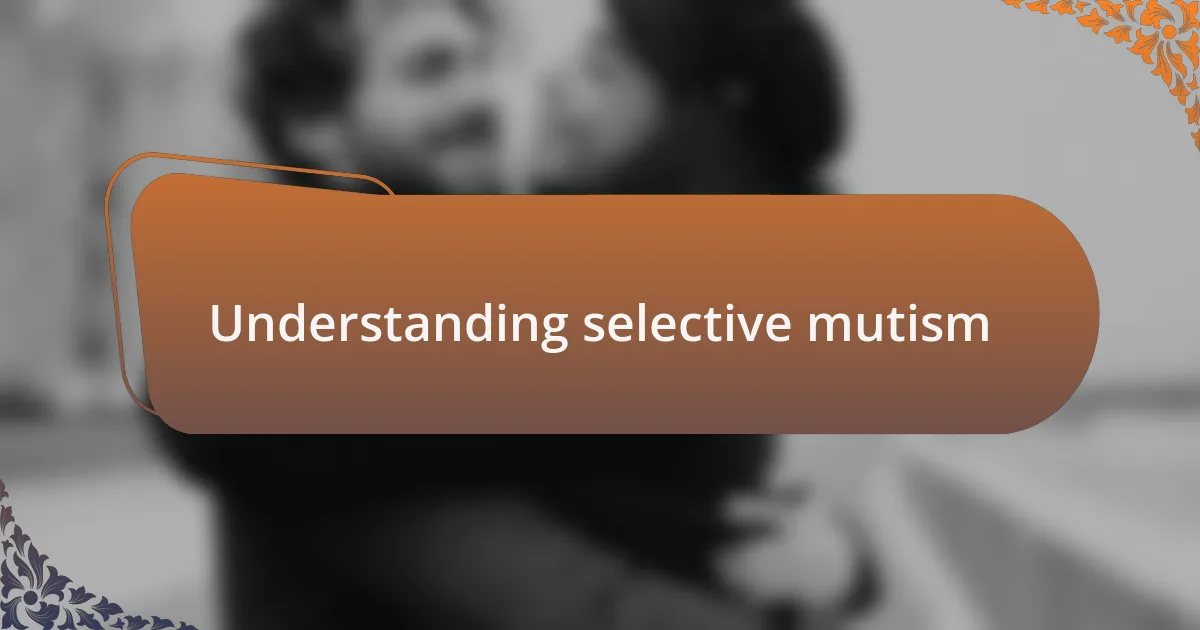
Understanding selective mutism
Selective mutism is a complex anxiety disorder that primarily affects children, manifesting as an inability to speak in specific social situations despite having the ability to communicate verbally in other environments. I remember once feeling a tight knot in my stomach at a school event; everyone was chatting away, but the thought of joining in seemed impossible. It made me wonder, could this silence be an expression of overwhelming anxiety rather than simple shyness?
As I learned more about selective mutism, I discovered that it’s not just about fear of speaking; it often stems from a combination of genetics, temperament, and environmental influences. Reflecting on my own experiences, I realized how important it was to create a safe space. Have you ever felt completely at ease with someone and then found it hard to express your thoughts? This sensation is all too familiar for those with selective mutism, as they often thrive in familiar settings but become paralyzed in new social contexts.
Understanding selective mutism also means recognizing the emotional weight carried by those who experience it. For instance, I recall feeling invisible in group settings when my voice wouldn’t come out, even when I desperately wanted to join the conversation. This struggle can cause significant distress and impact self-esteem, making it crucial for friends and family to approach with patience and support. How do we foster an inclusive environment where everyone feels valued and heard? By embracing gentle encouragement and empathy, we can help break down the barriers that silence creates.
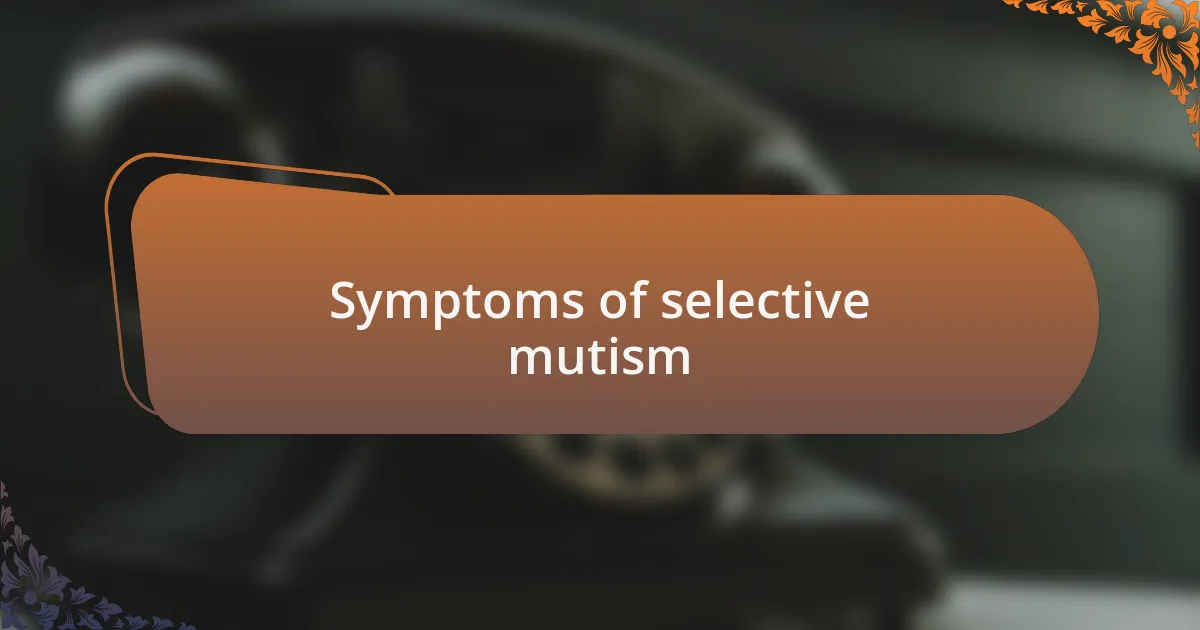
Symptoms of selective mutism
One prominent symptom of selective mutism is the marked reluctance or refusal to communicate in social settings. I still remember when my friends would play games at recess; while they laughed and shouted, I stayed on the sidelines, caught in a web of fear. It’s a heartbreaking experience, feeling the urge to speak but being unable to voice a single word.
Another symptom is that individuals with selective mutism often display a strong preference for familiar people and environments. In my own experience, I felt secure at home, where I could express myself freely, but stepping into a crowded classroom was a different story. I would often find myself retreating into silence, longing for the comfort of a trusted friend at my side; isn’t it fascinating how safety can influence our willingness to communicate?
Additionally, emotions like frustration and sadness often accompany the struggle to speak. There were countless moments when I watched others connect through conversation, aching to join in but feeling shackled by anxiety. If you’ve ever had an urgent thought on the tip of your tongue but felt trapped, you can imagine how isolating this experience can be for someone facing selective mutism. It’s not just about the inability to voice words; it’s about the emotional turmoil that remains unspoken.
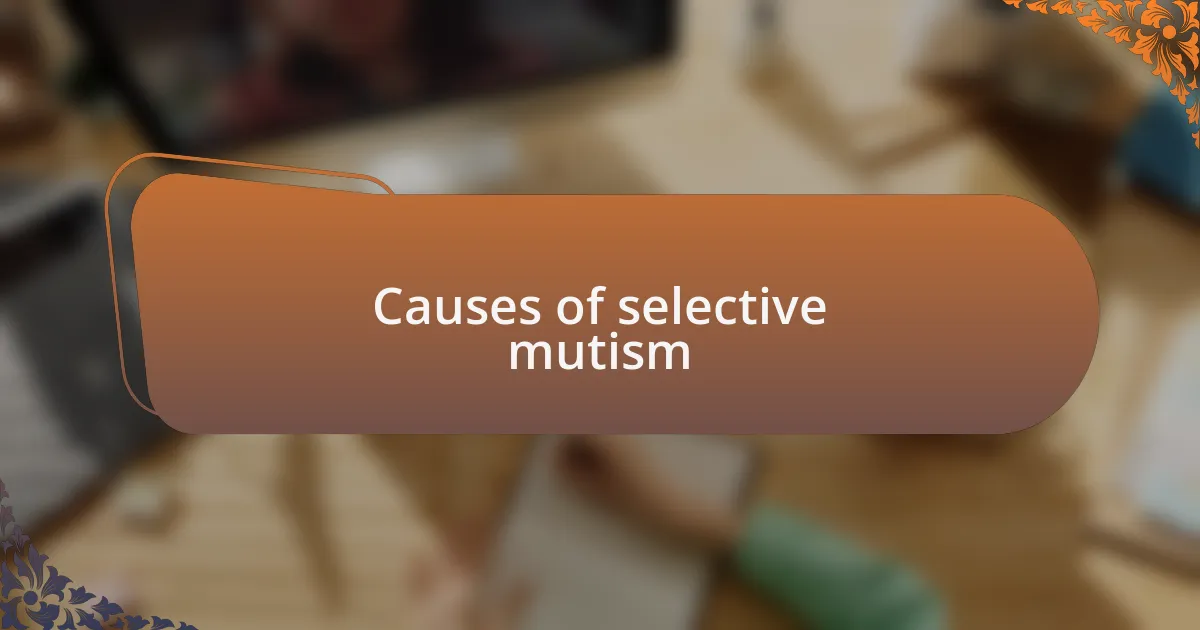
Causes of selective mutism
The causes of selective mutism can often be intertwined with both environmental and genetic factors. From my observations, many children who experience this condition come from backgrounds where anxiety is prevalent, either due to genetic predisposition or environmental stressors. I recall a friend whose parents were quite anxious themselves; their nervousness seeped into their child’s experiences, making social situations feel daunting.
Moreover, traumatic experiences can play a significant role in the development of selective mutism. I once met someone who, after a frightening encounter during a school event, suddenly found it nearly impossible to speak in front of classmates. It’s alarming how a single moment can shift a person’s reality, reinforcing the idea that sometimes, fear dictates our silence.
Additionally, some children may have a temperament that makes them naturally more reserved or shy. I’ve noticed that introverted personalities sometimes struggle more in group settings, feeling overwhelmed by the noise and chaos around them. It raises the question: how much of our personality shapes our ability to connect with others? For many, the answer lies in understanding their unique interplay of traits and experiences.
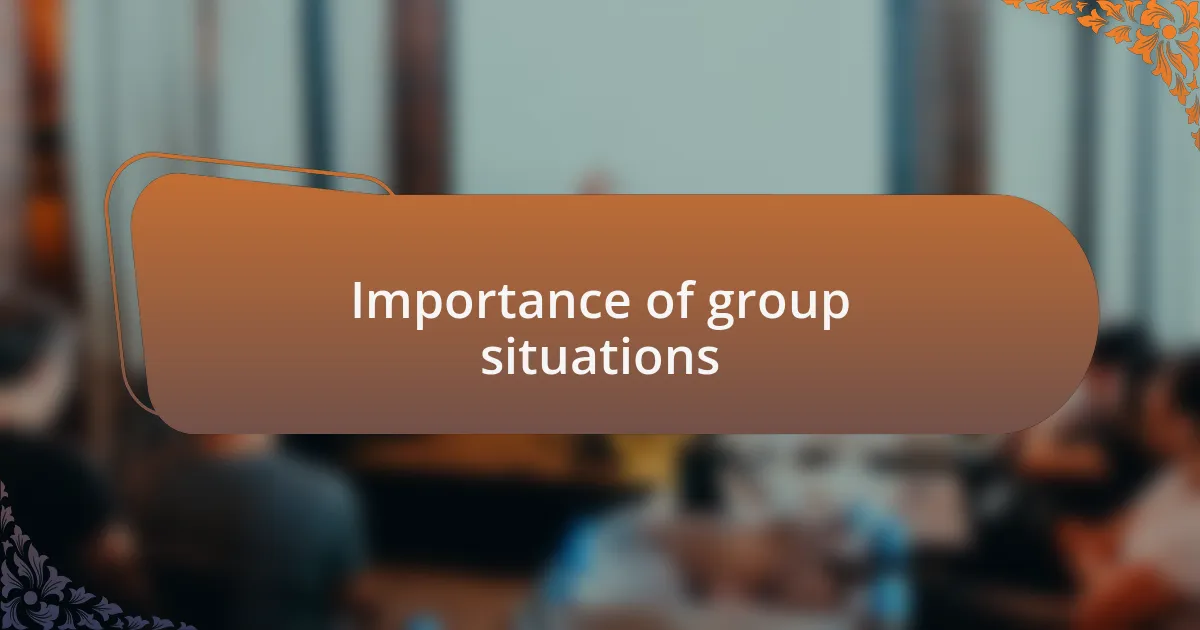
Importance of group situations
Engaging in group situations is essential for developing communication skills and social connections, especially for those with selective mutism. I remember the first time I attended a small group workshop focused on public speaking. The supportive environment helped me see that speaking up didn’t have to be frightening. It felt empowering to realize that others shared my hesitations.
Participating in group activities also fosters a sense of belonging, which can immensely benefit those who often feel isolated. I once joined a community art project where all participants were encouraged to express themselves freely. The joy of working alongside others not only eased my anxiety but created lasting friendships, showcasing how common interests can bridge the gap between silence and expression.
Additionally, group settings can provide a safe space for exposure to social challenges. During a recent team outing, I was initially nervous about sharing ideas in front of others. However, witnessing my friends support me, even when I stumbled, deepened my understanding of vulnerability. This experience made me wonder: how can we turn our fears into strengths within a group? It’s moments like these that highlight the importance of facing our fears together.
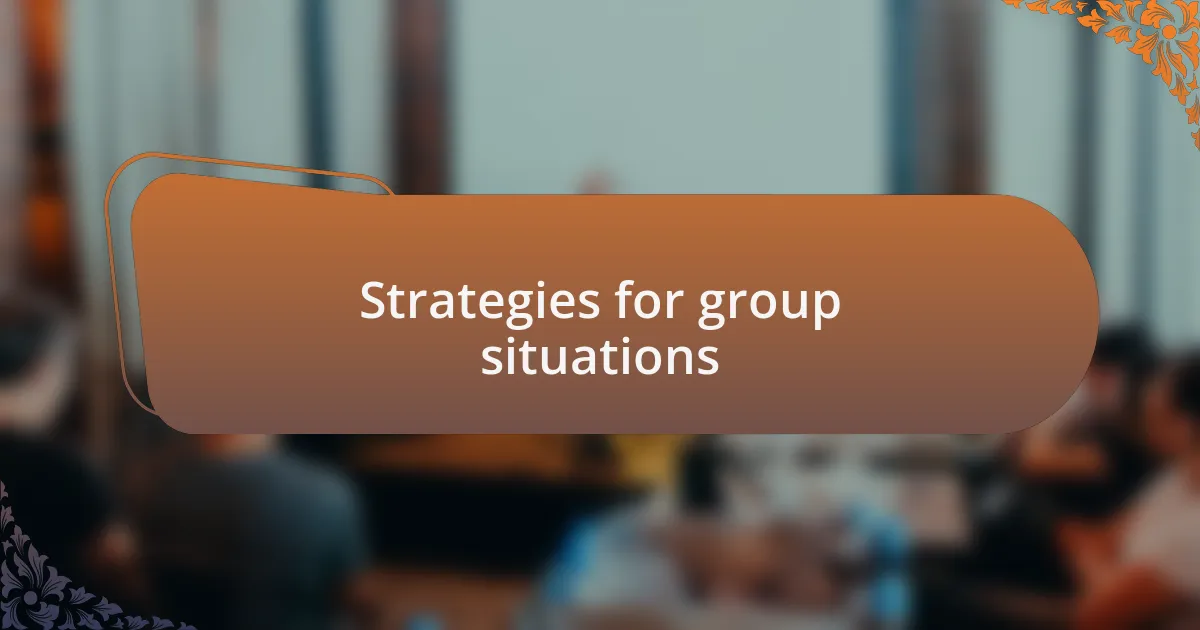
Strategies for group situations
Creating a comfortable environment is crucial when navigating group situations, especially for those with selective mutism. I find that bringing a trusted friend along can make a world of difference. Just recently, I attended a team meeting where having my buddy by my side eased my nerves, allowing me to focus on engaging rather than worrying about being judged. Have you ever noticed how much safer you feel when you have a familiar face nearby?
Using non-verbal communication can also be an effective strategy. I remember presenting in front of a group and opting to use visuals instead of relying solely on my words. The images conveyed my thoughts clearly, bridging the gap when words felt too daunting. It got me thinking: how often do we underestimate the power of our other senses in communication?
Setting small, achievable goals for participation can help reduce anxiety. In one of my group therapy sessions, I aimed to share at least one thought during each meeting. While it was a simple goal, the sense of accomplishment I felt each time I met it motivated me to push further. Isn’t it fascinating how small victories can gradually build our confidence in group interactions?
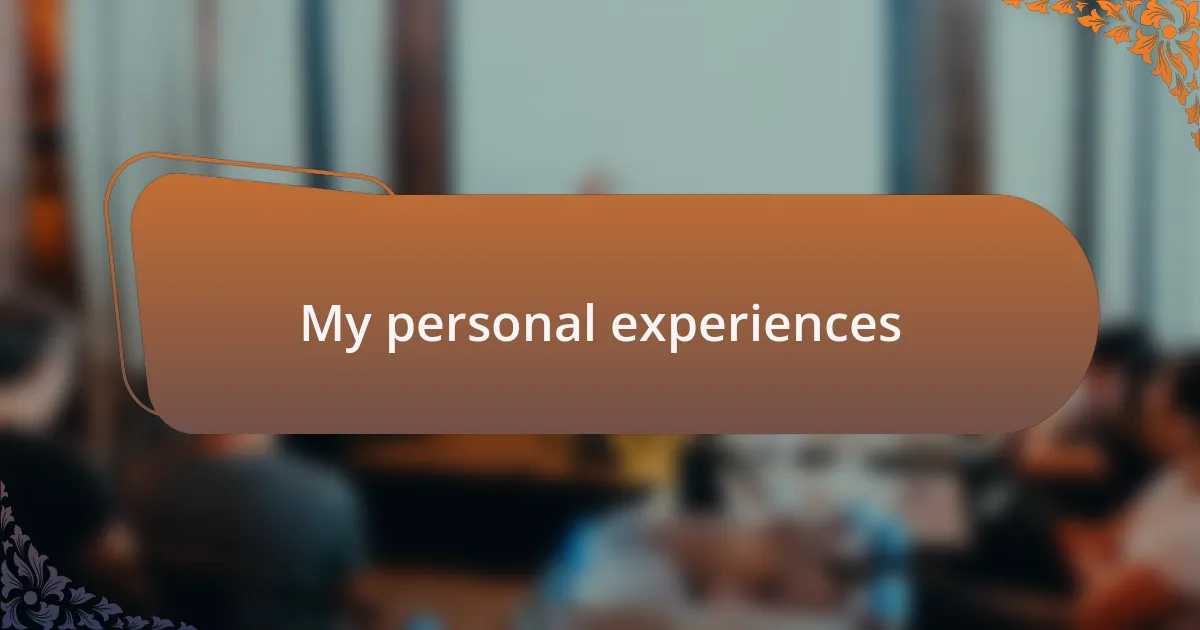
My personal experiences
There was a time when simply entering a room full of people could send my heart racing. I vividly remember attending a workshop where everyone was expected to introduce themselves. Instead of panicking, I focused on making eye contact with the facilitator, who offered a reassuring smile. It’s incredible how a friendly gesture can make such a significant impact in those moments of fear and uncertainty, isn’t it?
On another occasion, I tried a breathing exercise before joining a group outing. I would close my eyes for a brief moment, inhaling deeply and exhaling slowly, imagining the support of those around me. When I finally opened my eyes, I felt a wave of calm wash over me. It’s astonishing how something so simple can shift our mindset, making it easier to step into the world and engage with others.
Participating in group discussions has often felt intimidating, but there was a time when I shared a personal story during a peer support meeting. Afterward, several members approached me to express how relatable my experience was for them. That moment taught me a valuable lesson about vulnerability: sometimes, sharing our struggles can forge deeper connections. Have you experienced similar moments that fostered a sense of unity?
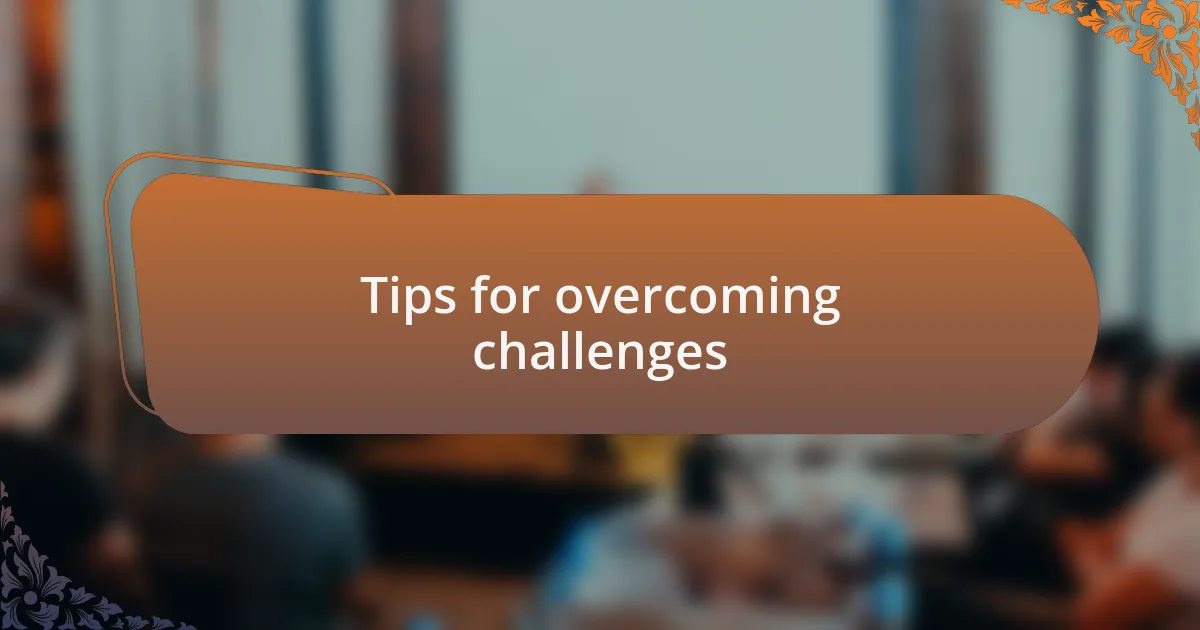
Tips for overcoming challenges
One effective tip for overcoming challenges in social situations is to establish a personal mantra. I remember creating one for myself: “This is a safe space.” Whenever the anxiety started creeping in, I would silently repeat it to ground myself. Have you ever tried developing a phrase that resonates with you? It can really make a difference in how you perceive the environment.
Another approach that I found helpful is to seek out a buddy system. For example, I’d often attend events with a close friend who understood my struggle with communication. Having someone by my side who could provide both encouragement and distraction turned intimidating experiences into manageable ones. How comforting would it be to know that there’s someone right there with you when nerves hit?
Additionally, preparing ahead of time can significantly ease anxiety. I started jotting down a few conversation starters or potential questions I could ask others. It might sound simple, but having a plan made me feel more equipped to engage. Have you considered your own ways to prepare before entering a group? This little effort can transform those daunting interactions into opportunities for connection.